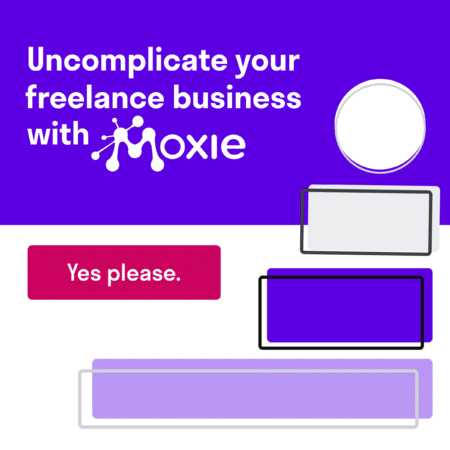Chances are if you’re reading this, you’re tired of pitching your services to crickets. You feel like you’re constantly being solicited by the clients you don’t want, and can’t even get those you do want to give you the time of day.
I used to feel that way, too.
When I first started freelancing, it was a constant struggle to line up work for myself. I spent hours drafting pitches and creative proposals, only to wait in radio silence for a response.
It wasn’t until I got very specific about what I was after that I began attracting more specific types of clients.
And now, for the past several years, I’ve used several very effective methods of networking and that have landed me high-paying, long-term contracts. In fact, these methods work so well that I’ve even had to turn down job offers from some of the largest consulting firms in the world!
And as you know, getting a client to inquire about your services is easy…it’s getting them to convert that takes a little bit more practice. Got a winning conversion tip? Share it with us!
To create your bulletproof creative proposal that converts, focus on these 3 main pillars:

1) Project summary
The first time a prospective client inquires about your services is the first opportunity for you to absolutely blow them away.
Offer a free consultation
Before you even get started drafting your proposal, offering your client a free consultation helps them assess their needs and hone in on their goal. Beginning a project with loose parameters will only slow down the creative process and increase the back-and-forth conversation.
Spend just a half hour talking to them about their needs, their goals, and their ambitions as a company or as an individual.
- Make suggestions about their project.
- Recommend they consider other ways of achieving their goal.
- Ask them what their competition is doing and why they feel like they need your expertise.
And make sure to take good notes, because you’ll need them later.
They’ll appreciate how inquisitive you are and it’ll make for a very good first impression. It’ll also give you a better understanding of exactly what they’re looking to get accomplished.

When a client feels you’re interested and invested in their goals, it becomes much easier for them to trust you and give you the credibility you deserve as a creative.
After you’ve talked in detail about their goals, it’s time to draft your proposal. The first section of your proposal should be a summary, and it should include these three things:
Summary of the client’s needs
Based on the consultation you gave them, you should have a pretty good understanding of what they’re looking for. Use the notes you took during the conversation and work them into the project summary.
- Use their words.
- Reiterate their goals.
It’ll feel familiar to them and they’ll feel reassured knowing that you listened attentively and put them and their goals first.
Description of your service
When describing what you do as a creative, it can be pretty easy to get carried away and slip off topic. Being a jack-of-all-trades is great, and while it may be the truth…it’s not what your client is looking to hear.
But when you describe what you do after a client has already told you exactly what they’re looking for, it’s easy to cater your description to be appealing to them.
This is your chance to brag.
Prove your credibility by articulating exactly what service it is you provide and why you do it better than anyone else. Mention past clients, past projects, and give yourself as much credibility as you can. You may even want to include a testimonial or two for added support.

But don’t get too carried away. Make sure the client still feels like they’re your number one priority. Tie your credibility back into their main objective.
Describe your particular skills (or the skills of your team)
Give a brief overview of your skills.
Include softwares, years of experience, and types of clients you like to work with. (this can be in list form. It doesn’t have to be long).
But, ONLY use skills and softwares that are relevant to your client!
Remember, you’re not trying to show them how creative and awesome you are. You’re trying to convince them you’re the absolute best person for this specific job.
(Note: this section should be no more than 1 – 2 pages long.)
2) Scope of services
Design your process as well as you design the project. Depending on the client you’re working with, they may not be familiar with the creative process.
More often than not, they’ll assume you can just wave your magic wand and make things happen. We’ve all heard this one, haven’t we:

You’re a creative wizard, can’t you just wave your wand over it?
This can be frustrating if you let it be.
OR, you can turn it into an opportunity to really impress them.
We all know what it feels like to be halfway through a project and have a client ask to see something completely new…and we hate that, don’t we?
To keep your client from going off on tangents during the design process, it’s imperative that you clearly establish a structure first.
Break it down into phases
Typically, I break my projects down into 3 phases. Give a brief description of each of these phases and make sure you follow suit as you begin working.
Phase 1: Concepts & Ideation (20%)
Your product isn’t the design. Your product is the idea. The design is just the vehicle that drives your idea.
It’s up to you to set expectations during this phase. It’s always smart to present them with a minimum of 3 different concepts or creative directions to move in before you really start designing or executing tactics.
- Give them options.
- Talk through those options.
- Make your client feel like they’re part of the creative process at its conception.
Once they sign off on an idea, it’s time for the next phase.
Phase 2: Design (70%)
This section of the proposal will point to hours spent doing the actual design work.
This is where the bulk of your work will be done; where you get into your creative zone and start doing the fun stuff!
Phase 3: Revisions (10%)
After you show the client the work you’ve done in phase 2, they will inevitably have slight variations they’d like to explore. Be willing to entertain these requests, but make sure you dictate that you can only spend 10% of the allotted time on this.
Overview of Deliverables
Include a list of exactly what your client will be receiving.
Example: If it’s a web design project, spell out what the client will be receiving (layered PSD, html files, images, etc.).
Be as thorough as you can.
When you’re done with the project, package everything mentioned in this section up in a single ZIP file and send it along to them.
That’ll help establish a clear “endpoint” to the project and prevent it from lingering on.
3) Project estimate
In a simple table (as seen below), assign the predicted duration and cost amounts to each phase of the project. Estimate how long each of those phases will take and factor in your cost per hour to arrive at a prediction of the total cost.
(This section will become more refined as you become more seasoned in your freelance career.)
Doing this will make it easier for you to stay on schedule and give you something to point to your project starts to slip out of scope.
For example, here’s a recent project I worked on below:
| Service | Rate | Phase | Hours | Total |
| Conception | $75/hr | 1 | 20 | $1,500 |
| Design | $75/hr | 2 | 70 | $5,250 |
| Revisions | $75/hr | 3 | 10 | $750 |
| — | — | — | — | $7,500 |
One more tip on pricing:
Never sell yourself short. It’s a common fear among freelancers that charging too much for your services may result in losing the client.
In my experience…when you charge less, the client expects less.
When you charge less, they’re less excited, they have fewer expectations, and they’re less likely to refer you to a friend…and as you know, referrals are huge.
Think about this domino effect…if a client hires you because you’re cheap, they’ll refer you because you’re cheap. As a result, you’ll be bombarded with clients who expect cheap work.
But, if a client refers you because you’re good, then you’ll be referred because of the phenomenal job you did. You’ll be “well worth it” to future prospects and your quality of work and quality of clientele will improve exponentially.
Start following these guidelines when creating your proposals. If you don’t win the project, they probably aren’t the client you want to be investing your time in anyway.
And, when you do land it…deliver 110% and ask for a referral. You’ll be shocked how far it will take you.
Good luck!
Keep the conversation going...
Over 10,000 of us are having daily conversations over in our free Facebook group and we'd love to see you there. Join us!


This was spot on. Almost exactly how we do our process and proposals as well. I loved the part where you said:
“Think about this domino effect…if a client hires you because you’re cheap, they’ll refer you because you’re cheap. As a result, you’ll be bombarded with clients who expect cheap work.
But, if a client refers you because you’re good, then you’ll be
referred because of the phenomenal job you did. You’ll be “well worth it” to future prospects and your quality of work and quality of
clientele will improve exponentially.”
Thanks, Mindy! It’s all a chain reaction 🙂
Drew…really great piece. I’ve been working on my own for 15 years and kind of let myself slip into autopilot (read: get lazy). My studio is going through some transition right now and as I’ve been working on being more proactive with marketing myself, putting proposals together has been kind of tough just because I kind of let those skills get rusty. This was a nice refresher. Thanks!
Beautiful to hear that, Shawn. Best of luck with the transition! Thanks for reading
Great tips! “Never sell yourself short” really hit home for me. Definitely will keep your points in mind when handling clients who complain about “high prices”!
Thanks so much Ariana! Glad you found it helpful. When you believe in the value you place on yourself, others will, too 😉
Thank you for the post, Drew! You make some very valid points. I will say, however, the LESS information on the calculation of the fees, the better. Extreme confidence is expressed in being minimal in how consulting work is priced and presented. I’ve tested this firsthand, and it works! Here’s something I wrote about Design Proposals that may be a nice addition to your post: http://www.yourcreativejunkie.com/design-proposals-10-tips-protect-ass/
LOVE your tip about if you price less, the client will expect less. TRUE STORY. Thank you sir,
– Vince
Hey Vincent! Thanks for the feedback, definitely some good points from your end as well.
I agree fully that minimal quotes can exude confidence in a consulting capacity. My point in elaborating on the process in a creative proposal is to help clients understand more about the creative process… something that I’ve found to be very foreign to many of the clients I’ve worked with.
Breaking it down this way I think leads to a better overall client experience and a more powerful referral from them in the end.
Hello Drew, yes I agree! I also list everything out in terms of process, but I just have one price associated with all of the steps at the end of the list. See below:
– – –
Custom Logotype Design
1. Research – Competitive overview & design research.
2. Conceptual Exploration – Sketches of potential visual approaches to the logo
3. Design Exploration – Once sketch selection is made, exploring color palettes and fonts.
4. Logo Revisions – 3 rounds of client revisions on the chosen creative direction.
5. Logo Delivery – Created in the industry standard vector application, Adobe Illustrator™.
6. Project Management – meetings, emails, client correspondence.
Total Fees: $xxxx
– – –
I think we are saying the same thing..
Thank you sir!
OMG! this was just what I needed… I am bookmarking this article and spending next weeks AM work hours to implement. thanks!
Awesome, thanks so much Danette! Glad you enjoyed it. Good luck!
Very Inspirational and helpful, I especially like the part where you say,
“if a client hires you because you’re cheap, they’ll refer you because you’re cheap. As a result, you’ll be bombarded with clients who expect cheap work.”
makes perfect sense…
Thanks, Stanley! I’m so glad you were inspired by this segment, as it’s one I firmly believe in.
If you focus on quality of your proposal and deliver 110%, not only will you increase the likelihood of a returning customer, but the quality of your leads will improve drastically. The minute you start to sacrifice your pricing is when you’ll attract the wrong type of projects 🙂
This was great Drew. I already utilize and implement aspects of what you mentioned. However, upon reading, certainly see opportunities for improvement!
Thanks so much!
Thanks Andrew… this came on time for a morning pitch meeting, I feel more stronger now I’m heading to the meeting.
Hey Barney – Glad to hear you found this useful! Hope the meeting went well 🙂